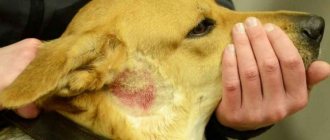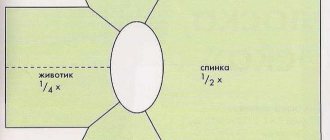Types of allergies in bulldogs
It is written above that the disease is provoked by numerous irritants surrounding the dog. The main types of allergies in French bulldogs look like this:
- food;
- for medications;
- chemical;
- immune (autoallergy);
- on the owner's hair or dandruff;
- for bites from fleas and other parasites.
Some types are clear, others raise numerous questions. We suggest we talk about each type separately and in more detail. Let's start with the well-known food allergic reaction.
Allergy symptoms
Unlike a person, whose nasopharynx is the first to suffer from an allergy, a dog immediately reacts with the epidermis. Typical skin irritations include:
- redness and inflammation;
- continuous itching (the animal scratches the skin until it bleeds);
- the appearance of ulcers, blisters and bloody ulcers;
- getting wet (sweating) armpits;
- thinning and hair loss;
- unpleasant smell.
Important! It is necessary to distinguish itching caused by inflammatory processes that accompany immune, infectious, parasitic or systemic diseases (such as diabetes) from itching due to allergies.
Pay attention to the location of the itching. If your pet scratches the perineum or the area at the base of the tail, this is an infestation with parasites or an allergic reaction to flea bites. Atopic dermatitis is characterized by itching near the nose, ears, abdomen and distal extremities.
Food allergies
How to choose food for French bulldogs with allergies? Before thinking about this issue, it is worth finding out what products provoke its occurrence.
Pets are big fans of tasty food. Many representatives of the breed do not perceive certain types of protein found in the following products:
- Chicken meat. Chicken is a known allergen, despite its low fat content and easy digestibility.
- Eggs. They must be present in the dog’s diet; it is recommended to give a boiled chicken egg once a week. This causes confusion among owners: on the one hand, the product causes allergies in French bulldogs, on the other hand, it is necessary for them. When offering your pet an egg, carefully observe its reaction. If redness occurs in the ears or face, the product is removed from the dog menu.
- Fermented milk products. Contrary to the opinion about their usefulness, kefir, cottage cheese and fermented baked milk are prohibited in the diet of French bulldogs.
- Yeast and soy. The last product is not very useful for people, let alone dogs.
- Red vegetables and fruits, this includes tomatoes and apples.
- Vegetable oils and fish oil.
As we can see, the list of products is extensive. A small amount may cause an allergy in a French bulldog, what should you feed him then? Give preference to super-premium or holistic dry food. By the way, information for novice owners: food allergies are cumulative. A dog can eat some food for six months and feel great, and then become covered in red sores.
External symptoms
How do allergies manifest in French bulldogs? Its presence is judged by external signs and changes in the dog’s behavior. The signs are as follows:
- constant problems with the ears, redness and rashes on them;
- the presence of mucus in excrement;
- seething in the stomach, colic, frequent gas with a very strong unpleasant odor;
- regular nausea and vomiting of bile;
- the appearance of red sores on the dog’s skin;
- incessant itching in the groin area of the animal;
- baldness;
- bright pink skin color;
- yellow dandruff, unpleasant odor from the pet.
Causes of hyperemia and accompanying symptoms
The main reason why a dog's testicles turn red is mechanical stress in the form of constant licking. It occurs under the influence of various factors.
Allergic reaction
It is caused by the following allergens:
- feed components;
- food from the table (sweet, smoked food);
- chemicals (for example, floor cleaners);
- plant pollen.
The allergy manifests itself as redness and the appearance of small pimples.
Bites
Hyperemia is caused by intolerance to substances carried by wasps, bees, etc. Some ticks carry rickettsia, causing the disease ehrlichiosis.
In addition to changes in color, swelling of the testicles is observed, and there may be hemorrhages.
A tan
Harmless factor. The color of the skin changes under the influence of sunlight. It becomes darker. It is observed mainly in dogs with short hair.
Prostate inflammation and bladder stones
Infections with prostatitis tend to spread to neighboring tissues, including the testicles.
Additional symptoms : pain during urination, fever, discharge mixed with pus from the genital organ.
The disease develops with excessive protein content in the diet, reduced drinking regimen, and in older dogs. The breed of your pet also influences the occurrence of the disease.
Spaniels, Dalmatians, Pekingese, bulldogs, and other breeds are most susceptible to urolithiasis. Stones in the bladder manifest themselves in the form of swelling, hyperemia (increased temperature) of the scrotum, urinary retention, and weakness. Sometimes bleeding from the genital organ is observed.
Inflammation of the paraanal glands
The glands are located under the skin on either side of the anal sphincter. Sometimes they become clogged, resulting in inflammation. This process is transient, so the testes are often affected.
Main symptoms: anxiety, itching, fever, unpleasant odor, anal discharge. If the inflammation spreads to the testicles, they will turn red, take on a swollen appearance, and swell.
Sexually transmitted diseases
If dogs have red testicles, this may be the result of bacteria being introduced during mating. The danger of these infections is that the symptoms take a long time to appear; the pet can feel healthy for up to 8 months.
The following diseases are transmitted sexually:
- Gonorrhea is an inflammation of the urethra caused by intensive proliferation of gonococci. Signs: scrotal hyperemia, swelling, pain during urination;
- Herpes is a viral disease whose symptoms do not appear for a long time. Manifested by the formation of ulcers and red spots on the genitals of the cables;
- sarcomas are tumor-like neoplasms that resemble a bright red cauliflower inflorescence. They occur only in dogs and have signs of cancerous tumors, but without the possibility of metastasis.
It is not possible to determine the presence of sexual diseases in a pet on your own, so consultation with a veterinarian is necessary.
Tumors
Benign and malignant neoplasms are the most dangerous diseases. In addition to the redness of the genitals, a lump appears that can be easily felt.
The danger of tumors is their long-term development, which is asymptomatic in the first stages.
Behavior Changes
How can you tell if your French Bulldog puppy is allergic to something? External signs are described above, here we will look at behavioral changes.
- A puppy or adult dog is constantly nervous.
- The animal becomes irritable, snaps when you touch it or dodges an outstretched hand.
- The pet is constantly itching and licking bothersome areas.
- In some cases, the “Frenchman” shakes his head, as if there is a foreign object in his ears that the dog wants to get rid of.
How to treat a pet?
Your veterinarian will tell you how to treat allergies in a French bulldog. This subsection is provided as general information; any independent treatment of the animal is strictly prohibited. It can lead to harmful consequences, including death.
First, the diagnosis is clarified and the irritant that causes the allergy is found. After this, the allergen is removed, and the dog is given antihistamines.
The easiest way to treat allergies in a French bulldog is a mixture of Sinaflan (human ointment, sold in any pharmacy) with baby cream. They claim that this method can relieve the animal of the most severe dermatitis.
The scabs on the ears and face are dried using a solution of furatsilin, ulcers on the body are smeared with ordinary brilliant green.
Safe Reasons
There are options in which acne on a dog’s face can be considered normal and does not require any action on the part of the owner:
Warts
They look like flesh-colored pimples ranging in size from a small grain to a pea. Very often found in animals with many folds (Shar Peis, bulldogs, boxers, pugs).
They are located mainly on the chin, eyelids, eyebrows and nasal fold. The main amount appears at an early age. In adults after 7 years, there may be up to several dozen warts throughout the body.
It is recommended to remove formations that are located in problem areas (eyelid, lip) and can interfere with the pet in everyday life. Today, cryodestruction using liquid nitrogen is considered the most effective method.
Damage or inflammation of the follicles
Dogs have a large number of follicles on their faces, which can become injured and inflamed. Even slight hypothermia can cause a red pimple the size of a small bead to appear.
In most cases, everything goes away without a trace within a couple of days. To calm down, you can wipe the area with a chlorhexidine solution to avoid infection.
Enlarged sebaceous glands
Common among Bulldogs, Pugs, Dobermans and Rottweilers. White pimples the size of a grain of rice appear on the face, which do not bother the animal in any way. When pressed, gray-white contents (sebum) may be released.
They can be detected even in puppyhood; they pose no danger until the sebaceous gland becomes inflamed. Then treatment of the affected area with antiseptic solutions is indicated.
Let’s also not forget about the most common colds, which periodically appear on the face of all dogs. They almost always go away on their own and do not interfere with the animal in any way.
Treatment of food allergies
What should owners do if they discover a food allergy in their French bulldogs? Be sure to follow the veterinarian’s instructions, do not self-medicate, and remove the allergen product. Here is a list of rules that must be followed if a pet has a food allergy:
- Provide your dog with the diet prescribed by your veterinarian. Most often, she requires removing protein from the diet.
- During the diet period, it is forbidden to pamper the dog. Pampering includes treats, chew toys, and various vitamins not prescribed by the doctor.
- Has your pet been prescribed antipruritic and antifungal medications? Be sure to use them for the required period.
- Exclude medications that are not included in the veterinarian's prescription.
- When the dog is on a natural diet, the diet includes rice and boiled beef.
- If the animal eats dry food, the veterinarian will prescribe the one the dog needs for the duration of the diet.
- As a rule, dietary restrictions are prescribed for 10-14 weeks, depending on the severity of the allergic reaction.
Prevention and healthy lifestyle
French bulldogs are prone to overeating, which can be accompanied by metabolic disorders, malfunctions of internal organs and problems with movement. That is why it is very important to provide your pet with sufficient and regular physical activity, as well as a nutritious diet.
The feeding regimen must be followed regardless of age. The range of products and their quantity when feeding natural food, as well as the composition of ready-made dry and wet food, must necessarily vary depending on the age, health and activity of the pet.
The senior dog category includes French bulldogs aged seven years or more. It is at this age that prevention is especially important, which will significantly reduce the risk of developing chronic diseases. With age, all dogs experience:
- decreased appetite and dulled sense of smell, so food should be sufficiently warm and of high quality; intolerance to fatty foods, therefore, in order to reduce the risk of developing pancreatitis, the amount of lipids in food should be minimized; increased load on the kidneys, so protein foods should also be given with some restrictions; decreased functional abilities of the senses, so it is necessary to regularly check hearing and vision; reducing the amount of oil secreted by the skin, so you need to reduce the number of times you bathe your pet; the appearance of callused skin thickenings on the paw pads and elbow joints, so such areas of the skin should be regularly lubricated with sea buckthorn oil or propolis-based creams.
It is equally important to follow the regime of anthelmintic procedures and timely treatment of your pet against ectoparasites . Preventive measures also include strict adherence to the French Bulldog vaccination schedule established by the veterinarian. Return to content
Preventive measures
We found out what provokes allergies in a French bulldog (a representative of the breed is pictured below). Now we’ll find out how to avoid its occurrence and protect your pet.
It all starts with keeping the house clean. Regular wet cleaning and dusting will help protect your pet from an allergic reaction.
As for food allergies, a preventive measure, according to many veterinarians, would be an intermittent diet of rice and beef. In the case when the French bulldog is on a natural diet, the diet is carried out once every two to three months. To prevent toxins from accumulating in your pet’s liver, he is given a Karsila tablet once a day.
The main French menu looks like this:
- The meat is lean and streaky. The exception is chicken and other poultry; they cause allergies in French bulldogs, as described above. The product is pre-frozen for at least three days. After which it is defrosted at room temperature, cut into small pieces, scalded with boiling water and given to the dog. Boiled meat is not welcome, only raw. The daily norm is 200-300 grams, depending on the weight of the bulldog.
- Sea fish, like meat, is frozen. Then it is thawed, thoroughly cleaned of scales and bones, and cut into small pieces. You can give fish no more than 4 times a week.
- Boiled chicken eggs are given once a week, the quantity does not exceed one. When feeding the product, carefully monitor the external reactions of the French bulldog.
- The offal is boiled a little before serving it to the dog.
- Rice and buckwheat are subjected to heat treatment.
- Vegetables are given in small quantities and boiled well. Ideally, they are mixed with meat or fish.
- Regarding dairy products, the opinions of breeders and owners of “Frenchies” vary. Some argue that you can give dogs kefir or cottage cheese once a week, while others are categorically against it. We recommend checking with the breeder whether he gave milk or not when purchasing a pet.











